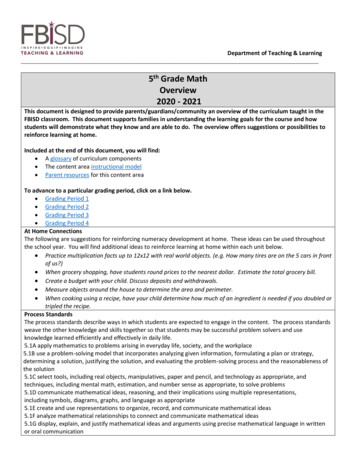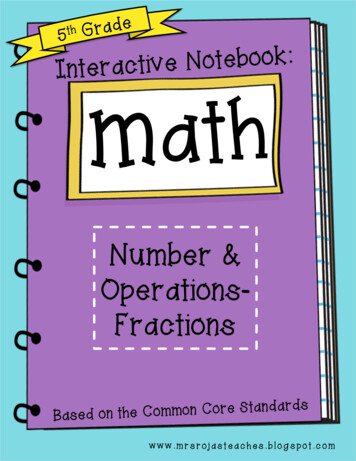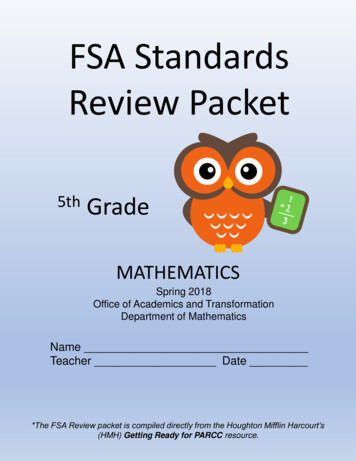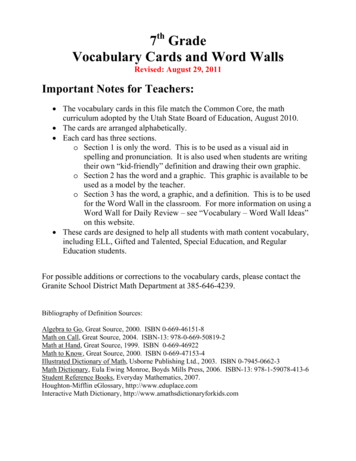
Transcription
Department of Teaching & Learning5th Grade MathOverview2020 - 2021This document is designed to provide parents/guardians/community an overview of the curriculum taught in theFBISD classroom. This document supports families in understanding the learning goals for the course and howstudents will demonstrate what they know and are able to do. The overview offers suggestions or possibilities toreinforce learning at home.Included at the end of this document, you will find: A glossary of curriculum components The content area instructional model Parent resources for this content areaTo advance to a particular grading period, click on a link below. Grading Period 1 Grading Period 2 Grading Period 3 Grading Period 4At Home ConnectionsThe following are suggestions for reinforcing numeracy development at home. These ideas can be used throughoutthe school year. You will find additional ideas to reinforce learning at home within each unit below. Practice multiplication facts up to 12x12 with real world objects. (e.g. How many tires are on the 5 cars in frontof us?) When grocery shopping, have students round prices to the nearest dollar. Estimate the total grocery bill. Create a budget with your child. Discuss deposits and withdrawals. Measure objects around the house to determine the area and perimeter. When cooking using a recipe, have your child determine how much of an ingredient is needed if you doubled ortripled the recipe.Process StandardsThe process standards describe ways in which students are expected to engage in the content. The process standardsweave the other knowledge and skills together so that students may be successful problem solvers and useknowledge learned efficiently and effectively in daily life.5.1A apply mathematics to problems arising in everyday life, society, and the workplace5.1B use a problem-solving model that incorporates analyzing given information, formulating a plan or strategy,determining a solution, justifying the solution, and evaluating the problem-solving process and the reasonableness ofthe solution5.1C select tools, including real objects, manipulatives, paper and pencil, and technology as appropriate, andtechniques, including mental math, estimation, and number sense as appropriate, to solve problems5.1D communicate mathematical ideas, reasoning, and their implications using multiple representations,including symbols, diagrams, graphs, and language as appropriate5.1E create and use representations to organize, record, and communicate mathematical ideas5.1F analyze mathematical relationships to connect and communicate mathematical ideas5.1G display, explain, and justify mathematical ideas and arguments using precise mathematical language in writtenor oral communication
Department of Teaching & LearningGrading Period 1Unit 1: Represent & Solve Multi-Step Problems with Whole NumbersEstimated Date Range: 8/17/20 – 9/11/20Estimated Time Frame: 19 daysUnit Overview:In this unit, students will focus on representing multi-step problem situations involving whole numbers and all fouroperations using equations and a letter standing for an unknown quantity (e.g. Students will also solidify theiroperations with whole numbers from fourth grade while developing the understanding simplifying numericexpressions involving up to two levels of grouping symbols.At home connections: Use positive affirmations to build a growth mindset (“I can do it!” attitude) towards math. Recognize that math happens every day. (e.g. number of pages read in a book, dozen eggs is 12, telling time,etc.) Discuss situations that require an order to complete them and the importance of the order. (e.g.gettingdressed, bedtime routines, etc.) Discuss story problems with your child and have them determine the operations needed to solve.Concepts within Unit #1Success Criteria for this conceptLink to TEKSConcept #1: Launching MathematicalThe focus of this concept is on students getting used to classroom routinesMindsetswhile engaging in math related activities that promote sense- making,perseverance, and teamwork.Concept #2: Simplifying NumericExpressions5.4F, 5.4EConcept #3: Writing and SolvingEquations5.4B, 5.4F, 5.4E Describe the meaning of parentheses and brackets in a numericexpression.Explain the order in which to simplify a numeric expression.Simplify expressions without grouping symbols.Simplify expressions with grouping symbols.Represent a multi-step problem with strip diagrams.Represent a multi-step problem with a number line.Represent a multi-step problem with a letter standing for the unknown.Solve a multi-step problem using equations.Explain how an equation or representation matches the problem.Unit 2: Compare & Order DecimalsEstimated Date Range: 9/14/20 – 9/25/20Estimated Time Frame: 10 daysUnit Overview:In this unit, students will compare and order two decimals to the thousandths and represent comparisons usingsymbols. They will also represent the value of digits in decimals using expanded notation and numerals. Students willalso round decimals to the tenths or hundredths place.At home connections: Provide your child with a number and ask them to represent the value of a digit. Find examples of numbers to the tenths place, hundredths place, and thousandths place in the real world.Create a chart to show the examples and explain how the numbers are used. Compare and order prices from ads in the newspaper. Discuss what makes a number greater or less thananother number and how they know.
Department of Teaching & LearningConcepts within Unit # 2Link to TEKSConcept #1: Representing Decimals5.2A, 5.2CSuccess Criteria for this concept Concept #2: Comparing and OrderingDecimals5.2B, 5.2A Use concrete and pictorial models to represent the value of a digit to thethousandths.Use expanded notation to represent the value of a digit to thethousandths.Use numerals to represent the value of a digit to the thousandths.Use place value understandings to round decimals to the tenths place.Use place value understandings to round decimals to the hundredthsplace.Compare two decimals to identify which is greater using place valueunderstanding.Compare two decimals to identify which is less using place valueunderstanding.Represent the comparison of two decimals with symbols ( , , ).Justify the comparison of decimals.Justify the order of a set of decimals (three or more numbers withdecimals).Unit 3: Addition & Subtraction of Positive Rational NumbersEstimated Date Range: 9/28/20 – 10/29/20Estimated Time Frame: 24 days (GP1-10 days and GP2-14 day)Unit Overview:In this unit, students will add and subtract positive rational numbers (whole numbers, decimals, and fractions,including improper fractions and mixed numbers). Students will represent problems that involve operations withfractions, not just solve. Fractions may not have the same denominator so students will need to use strategies suchas decomposing and composing fractions not just finding a common denominator.At home connections: Use sport statistics to determine who has a better batting average or 3 point shooting percentage. Provide your child with recipes and have them add the total amount of dry ingredients or liquid ingredients. Write story problems using numbers from ads in the newspaper.Concepts within Unit # 3Success Criteria for this conceptLink to TEKSConcept #1: Adding and Subtracting Add fractions with unequal denominators using concrete models.Fractions Subtract fractions with unequal denominators using concrete models.5.3K, 5.3A, 5.3H, 5.4A Add fractions with unequal denominators using pictorial models. Subtract fractions with unequal denominators using pictorial models. Estimate using benchmark fractions. Explain how to use benchmark fractions to estimate solutions. Use concrete and pictorial models to represent factors of wholenumbers up to 50. Identify if a number is prime or composite. Add fractions with unequal denominators. Subtract fractions with unequal denominators.
Department of Teaching & LearningGrading Period 2Unit 3: Addition & Subtraction of Positive Rational Numbers (Continued)Estimated Date Range: 9/21/20 – 10/29/20Estimated Time Frame: 24 days (GP1-10 days and GP2-14 days)Concept #1: Adding and Subtracting Fractions (continued) – see above5.3K, 5.3A, 5.3H, 5.4AConcepts within Unit # 3Link to TEKSConcept #2: Adding & SubtractingDecimals5.3K, 5.3AConcept #3: Adding & SubtractingPositive Rational Numbers5.3K, 5.3ASuccess Criteria for this concept Estimate decimals using number lines.Explain how to use benchmark decimals to estimate solutions.Add whole numbers and decimals using various strategies.Subtract whole numbers and decimals using various strategies.Estimate using benchmark fractions and decimals.Explain how to use benchmark fractions and decimals to estimatesolutions.Add fractions to decimals using various strategies.Subtract fractions from decimals using various strategies.Explain the process taken to add a decimal and fraction.Unit 4: Multiplication & Division of Whole NumbersEstimated Date Range: 11/02/20 – 12/04/20Estimated Time Frame: 20 daysUnit Overview:In this unit, students will multiply and divide whole numbers. Students will extend their knowledge of multiplicationand division to larger place values. The focus will be for students to understand the standard algorithm so they canmake connections when multiplying and dividing decimals later in the year. By the end of this unit, students will beproficient in writing and solving equations for one and two-step multiplication and division problems.At home connections: Practice skip counting to learn their multiplication facts. Create story problems that require multiplication or division to solve. Discuss scenarios such as planning a party or a vacation. Determine what steps need to happen to figure outthe total cost and what operations would be required for each step.Concepts within Unit # 4Link to TEKSConcept #1: Multiplying and DividingWhole Numbers5.3B, 5.3C, 5.3ASuccess Criteria for this concept Represent a product using an equation with a variable.Multiply a 3-digit by a 2-digit number using the standard algorithm.Represent problems involving multiplication using strip diagrams orequations.Represent a quotient using an equation with a variable.Divide a 4-digit dividend by a 2-digit divisor using various strategies.Divide a 4-digit dividend by a 2-digit divisor using standard algorithm.Represent problems involving division using strip diagrams or equations.
Department of Teaching & Learning Concept #2: Writing and SolvingEquations with Whole Numbers5.4B, 5.3C, 5.3B, 5.4F Represent multi-step problems with strip diagrams and/or numberlines.Represent multi-step problems with equations using a letter standing forthe unknown.Solve multi-step problems using equations when the letter isolated onone side of the equal sign.Explain how an equation or representation matches the problemsituation.Estimate to predict a solution and determine reasonableness of asolution.Represent a multi-step problem with strip diagrams.Represent a multi-step problem with a number line.Represent a multi-step problem with a letter standing for the unknown.Solve a multi-step problem using equations.Explain how an equation or representation matches the problem.Unit 5: Algebraic ReasoningEstimated Date Range: 12/07/20-1/22/20Estimated Time Frame: 22 days (GP1-10 Days and GP3-12 Days)Unit Overview:In this unit, students will graph ordered pairs of numbers in the first quadrant of the coordinate plane, recognize thedifference between additive and multiplicative patterns in a table or graph, and create and analyze data using ascatter plot.At home connections: Have your child find locations on a map. Use cardinal directions to explain how to get to a location. Ask your child to describe the process for graphing ordered pairs. Play the game BattleshipConcepts within Unit # 5Success Criteria for this conceptLink to TEKSConcept #1: Graphing on a Coordinate Describe the key attributes of the coordinate plane, including the x- andPlaney-axes and the origin.5.8C, 5.8A, 5.8B, 5.9B Describe the location of a coordinate in reference to the origin. Describe the process for graphing ordered pairs. Explain how to move along a coordinate plane to get from one point toanother. Plot ordered pairs in the first quadrant of the coordinate plane. Plot ordered pairs generated from number patterns and input-outputtables. Interpret real-world data represented in coordinate grids. Interpret real-world data to create a scatterplot. Draw conclusions and make predictions using information from ascatterplot. Generate questions using information from a scatterplot.
Department of Teaching & LearningGrading Period 3Unit 5: Algebraic Reasoning (continued)Estimated Date Range: 12/07/20-1/22/20Estimated Time Frame: 22 days (GP1-10 Days and GP3-12 Days)Unit Overview:In this unit, students will graph ordered pairs of numbers in the first quadrant of the coordinate plane, recognize thedifference between additive and multiplicative patterns in a table or graph, and create and analyze data using ascatter plot. In previous grades, students represented problems using input-output tables and numerical expressionsto generate a number pattern that follows a given rule. Students in future grades will graph ordered pairs in all fourquadrants of the coordinate plane and continue to analyze data in a variety of graphical representations.At home connections: Determine the difference between additive and multiplicative patterns. Discuss the relationship between two sets of data on a scatterplot. i.e. outside temperature and ice creamsalesConcepts within Unit # 5Link to TEKSConcept #2: Additive and Multiplicative Relationships5.4C, 5.8C, 5.4D, 5.9BSuccess Criteria for this concept Generate a numerical pattern when given a rule in theform y x a and graph the results.Generate a numerical pattern when given a rule in theform y ax and graph the results.Describe the difference between additive andmultiplicative patterns.Graph in the first quadrant of the coordinate plane.Interpret real-world data to create a scatterplot.Draw conclusions and make predictions usinginformation from a scatterplot.Generate questions using information from ascatterplot.Unit 6: Multiplication & Division of Fractions/DecimalsEstimated Date Range: 1/25/21-2/26/21Estimated Time Frame: 22 daysUnit Overview:In this unit, students will multiply and divide fractions and decimals. They will use models and representations todevelop a conceptual understanding of multiplying two numbers less than one. They will also be introduced towriting a remainder as a decimal.At home connections: Have your child make fractions using real world objects(e.g. What is the fraction of Fridays in the month ofAugust?).Students create their own story problems using money that would require multiplication or division to solve.Concepts within Unit # 6Success Criteria for this conceptLink to TEKS
Department of Teaching & LearningConcept #1: Multiplying and Dividing Fractions5.3L, 5.3I, 5.3J Concept #2: Multiplying and Dividing Decimals5.3E, 5.3G, 5.4F, 5.4C, 5.3D, 5.3F, 5.3A Represent a fraction using concrete objects andpictorial models.Use concrete objects and pictorial models to: Multiply a whole number and a fraction Divide a unit fraction by a whole number Divide a whole number by a unit fractionDivide a whole number by a unit fraction and unitfraction by a whole number.Represent a decimal using concrete objects andpictorial models.Use concrete objects and pictorial models to: Multiply a decimal and a whole number Multiply a decimal and decimal Divide a decimal by a whole numberMultiply a decimal and a whole number using thestandard algorithm.Multiply a decimal by a decimal using the standardalgorithm.Divide a decimal by a whole number using thestandard. algorithmUnit 7: Geometry & MeasurementEstimated Date Range: 3/1/21 – 4/14/21Estimated Time Frame: 24 days (GP3- 10 Days and GP4-14 Days)Unit Overview:In this unit, students will build on their knowledge of shape attributes. They will label the attributes and sort thembased on their properties. Students need to recall the shapes based on their names. Students will understandvolume of rectangular prisms. Concrete models will be used to determine the area of a layer and then how manylayers it will take to fill the rectangular prism. Students will also solve for area and perimeter and explain how theseconnect to volume. This will build to calculating surface area of shapes in future grades. Students will convert withincustomary or metric measurements (e.g. change inches to feet or meters to centimeters).At home connections: Go on a scavenger hunt outside and find geometric shapes. Have your child name them and describe theirattributes. Find two geometric shapes in your house and have your child describe the similarities and differencesbetween them.Concepts within Unit # 7Link to TEKSConcept #1: Classifying Two-Dimensional Figures5.5ASuccess Criteria for this concept Label shapes using markings for: Congruent lines Congruent angles Parallel lines Right angles Name polygons based on the number of sides.
Department of Teaching & Learning Name polygons based on the attributes of their sides. Name a polygon based on their angle measure. Name a polygon with the most specific name andexplain how I know. Sort polygons into graphic organizers using attributesand properties when given a picture. Sort polygons into a graphic organizer using attributesand properties when given a name. Explain why and how I sorted by shapes using formalgeometric language. Describe the relationship between polygons within thegraphic organizer.Grading Period 4Unit 7: Geometry & Measurement (continued)Estimated Date Range: 3/1/21 – 4/14/21Estimated Time Frame: 24 days (GP3- 10 Days and GP4-14 Days)At home connections: Measure objects in your house and find the perimeter and/or area. Discuss units of measure and which unit is best to use when measuring.Concepts within Unit # 7Link to TEKSConcept #2: Understanding Volume5.4G, 5.6A, 5.6BSuccess Criteria for this concept Concept #3: Area, Perimeter, and Volume5.4H, 5.4G, 5.6A, 5.6B Concept #4: Conversions Represent volume using concrete objects and pictorialmodels.Fill rectangular prisms with cubes to determine thevolume.Use the base of figures and the number of layers todetermine the volume.Describe perimeter and solve problems involvingperimeter.Describe area and solve problems involving area.Explain the different between perimeter and area.Describe volume and solve problems involving volume.Explain the connection between area and perimeterand solve problems as it relates to volume.Identify units of measure being used.
Department of Teaching & Learning4.8B, 5.7A Describe the relationship between two units ofmeasure. Represent conversions using tables. ConvertbetweenLiteracyunits of measure within the sameUnit 8: Data Analysis and PersonalFinancialsystem.Estimated Date Range: 4/15/20-5/10/20Estimated Time Frame: 17 daysUnit Overview:In this unit, students will represent categorical and numerical data using different types of graphs. This includes datawith whole numbers, decimals, and fractions. Students are also expected to solve one- and two-step problemsinvolving data. In addition to data analysis, students will also define various types of tax and explain the differencebetween gross and net income. Students will continue to learn about financial behaviors, such as borrowing, saving,spending, and budgeting.At home connections: Create a survey and have your child graph the results found. Ask them questions based on the informationdisplayed in the graph. Create a budget for the month and keep track of credits and debits.Concepts within Unit # 8Link to TEKSConcept #1: Data Analysis5.9C, 5.9ASuccess Criteria for this concept Concept #2: Personal Financial Literacy5.10A, 5.10B, 5.10C, 5.10D, 5.10E, 5.10F Collect and sort data using a frequency table.Explain a frequency table, bar graph, stem-and-leaf, dotplot, and scatterplot is and why you use them.Answer questions using information from graphs.Generate questions using information from graphs.Define income tax, property tax, sales tax, and propertytaxIdentify gross income and net income.Explain the difference between gross income and netincome.Identify different methods of payment includingchecks, credit card, debit card, and electronicpayments.Explain the advantages and disadvantages of differentmethods of payment.Balance a simple budget.Unit 9: Essential Understanding of 5th GradeEstimated Date Range: 5/11/20-5/26/20Estimated Time Frame: 12 daysUnit Overview:In this unit, students will review fifth grade skills to solidify their understanding so they are successful sixthgraders. They will focus primarily on numeracy, computational skills, and algebraic reasoning.At home connections: Have your child tell you their favorite thing they learned this year in math and why.Concepts within Unit # 9Success Criteria for this concept
Department of Teaching & LearningLink to TEKSConcept #1: Multi-Step Problems with Positive RationalNumbers5.4F, 5.4B, 5.3K, 5.3C, 5.3B, 5.4F, 5.4E Represent a multi-step problem with a letter standingfor the unknown.Solve a multi-step problem using equations.Explain how an equation or representation matches theproblem.
Department of Teaching & LearningGlossary of Curriculum ComponentsOverview– The content in this document provides an overview of the pacing and concepts covered in a subject for theyear.TEKS – Texas Essential Knowledge and Skills (TEKS) are the state standards for what students should know and be ableto do.Unit Overview – The unit overview provides a brief description of the concepts covered in each unit.Concept – A subtopic of the main topic of the unit.Success Criteria—a description of what it looks like to be successful in this concept.Competency—Standards-Based Grading communicates students’ understanding of the Texas Essentials Knowledgeand Skills (TEKS). Using the TEKS, teachers developed grade-level competencies to communicate student progress inthe Standards-Based gradebook. The competencies are the same for each grade-level content area (i.e. 1st grademath) across the district. Teachers report students’ progress on the competencies using learning progressions.Parent ResourcesThe following resources provide parents with ideas to support students’ understanding. For sites that are passwordprotected, your child will receive log-in information through their campus.ResourceEnvision MathDidax Virtual ManipulativesMath Learning Center Math AppsParent Resources from youcubed.orgStudent Resources from youcubed.orgMath: Why Doesn’t Yours Look LikeMine?Math4TexasHow it supports parent and studentsThis is the state adopted textbook for elementary schoolmath. Click on the link for directions on accessing thetextbook.These online resources provide access to virtualmanipulatives.This resource from youcubed.org includes articles forparents on ways to support their students in learning andunderstanding mathematics.This resource from youcubed.org includes videos concerning growthmindset in mathematicsThis resource provides an explanation of why math looksdifferent now as opposed to how parents learnedmathematics and how to support students in learningmathematics.This resources breaks down grade level standards, provides examplequestions, vocabulary, and links to online resources for students alignedto the standards.Instructional ModelThe structures, guidelines or model in which students engage in a particular content that ensures understanding ofthat content.
Department of Teaching & LearningThe instructional model for mathematics is the Concrete-Representational-Abstract Model (CRA).The CRA model allows students to access mathematics content first through a concrete approach (“doing” stage) thenrepresentational (“seeing” stage) and then finally abstract (“symbolic” stage). The CRA model allows students toconceptually develop concepts so they have a deeper understanding of the mathematics and are able to apply andtransfer their understanding across concepts and contents. The CRA model is implemented in grades K-12 in FBISD.
5th Grade Math Overview 2020 - 2021 This document is designed to provide parents/guardians/community an overview of the curriculum taught in the . (e.g. number of pages read in a book, dozen eggs is 12, telling time, etc.) Discuss situations that require an order to complete them and the importance of the order. (e.g.getting










